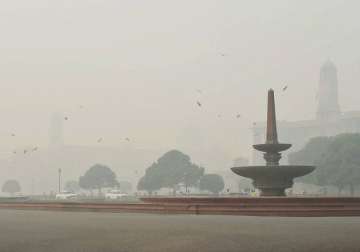Delhi faces worst smog in 17 years; Centre convene meeting of neighbouring states
Air pollution continues to be severe in Delhi with visibility reducing to the second lowest recorded in at least 10 years for November on Thursday.

Air pollution continues to be severe in Delhi with visibility reducing to the second lowest recorded in at least 10 years for November on Thursday.
News agency IANS, however, quoting experts reported that the smog that enveloped the national capital on Wednesday was worse in the last 17 years.
On Thursday morning, the city's air quality index had again gone off the scale at 500+, a level it had reached a day after Diwali.
At the Safdarjung area, the visibility was 50m at 5.30am, according to the India Meteorological Department (IMD) data.
“We checked November data of the last 10 years and found that only once had visibility fallen below 50m (on November 20, 2011),” Ravinder Vishen, head, Regional Weather Forecasting Centre, said.
Also several schools in the city and neighbouring towns suspended classes and outdoor activities.
The IMD also showed that visibility at Safdarjung and Palam on Thursday between 11.30 a.m. and 2.30 p.m. was 400 and 500 metres respectively due to smog.
Based on the IMD data, Centre for Science and Environment (CSE) experts pitched for emergency steps to save people from respiratory and heart diseases.
The emergency steps, they suggested, includes staying indoors.
“The government should aggressively advise people to stay indoors and avoid outdoor exercises. At the same time, it should roll out stringent winter pollution control from all sources along with emergency action,” Anumita Roychowdhury, head of CSE's air pollution division, said.
As per the experts, unending burning of paddy stubble in Punjab, Harayana and Uttar Pradesh, low winds and pollution during Diwali and other sources of pollution along with weather-related factors led to such abnormal levels of smog.
As per meteorological scientists, there was virtually no wind in the vertical column, which is expected to persist for a few more days.
"Satellite images from National Aeronautics and Space Administration's fire mapper have showed that paddy burning in Punjab, Haryana and Uttar Pradesh have increased after Diwali. The images clearly revealed that after October 30, crop residue burning in these states became more aggressive, which contributed to the severe smog in the national capital," the CSE said.
On Wednesday, Delhi's Indira Gandhi International Airport recorded the worst smog in 17 years with visibility as low as 300-400 metres.
Data from Delhi Pollution Control Committee shows that the levels of PM2.5 (particulate matters with diameter less than 2.5 mm) have increased by 62.7 per cent on November 2 as compared with that on Diwali. On November 2, the levels were 9.4 times the standard norms.
Urging the central government to intervene as it would take several state governments to work together, experts suggest the ailing persons to stay indoors and cautioned people to avoid outdoor exercises for a few days.
"Delhi needs an effective winter pollution mitigation plan that can make a difference. Without strong action, smog is only expected to get worse this winter at serious public health costs," Roychowdhury added.
Centre to hold meeting with Delhi’s neighbouring states
Meanwhile, the Centre has called a meeting with Delhi's neighbouring states today to discuss the national capital's deteriorating air quality.
The Secretary of Union Ministry of Environment, AN Jha, will be meeting the Secretaries of neighbouring states -- Haryana, Uttar Pradesh, Rajasthan and Punjab -- of the national capital, the government said on Thursday in a statement.